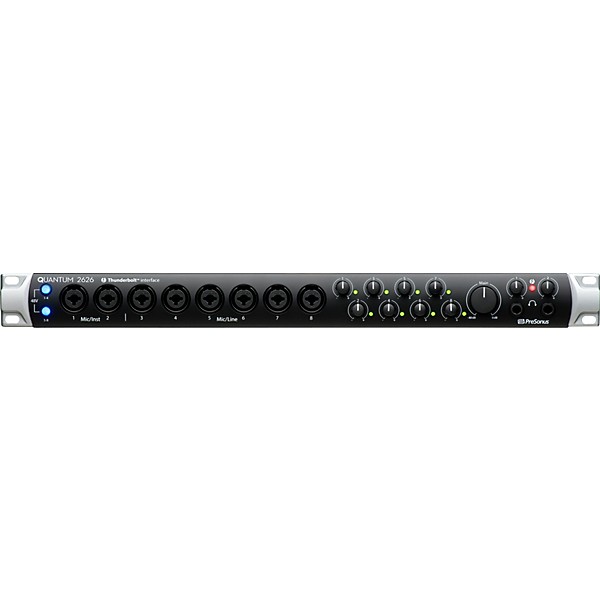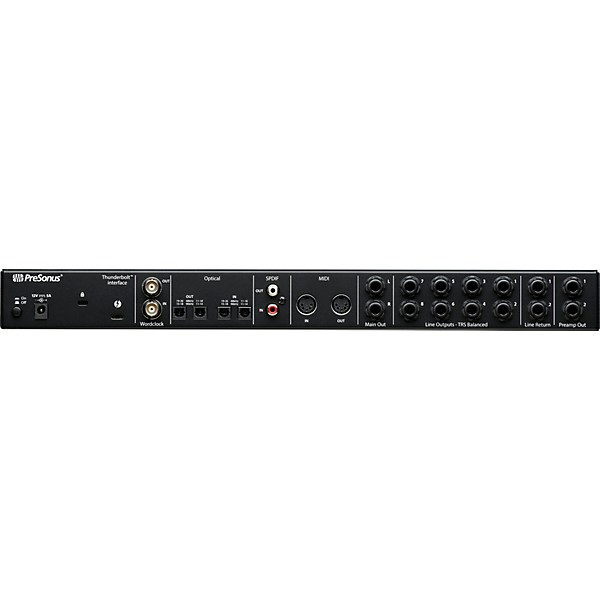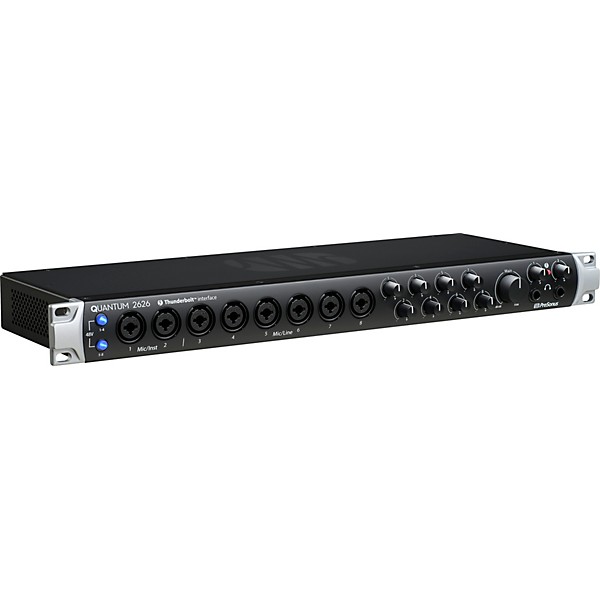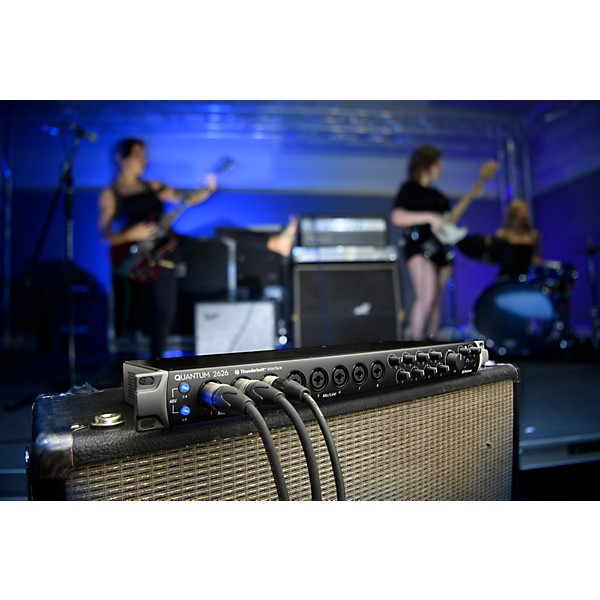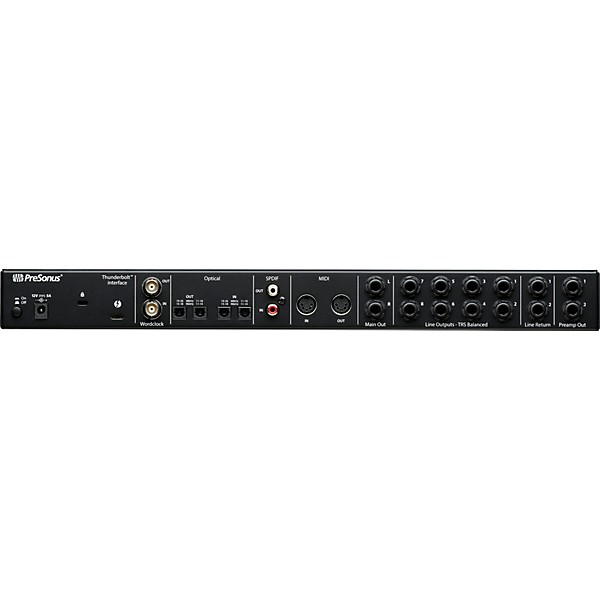- Popular Brands
PreSonus Quantum 2626 Thunderbolt 3 Audio Interface

 Description
Description
Timeless Audio
The Quantum 2626’s completely redesigned Thunderbolt driver delivers ultralow-latency performance. It features cutting-edge 24-bit/192kHz converters with 115dB of dynamic range and superior low-jitter clocking. Coupled with ultratransparent, pure analog PreSonus XMAX preamps, the 2626 serves up superb audio quality.Superior Sound
The Quantum 2626 audio interface operates at up to 192kHz for ultrahigh-definition mixing and recording. High-quality converters provide 115dB of dynamic range. This helps capture complex harmonics naturally with no audible distortion. The Quantum 2626 also features acclaimed XMAX Class A analog microphone preamps. These deliver high headroom, deep lows, smooth highs and a rich, overall sound.Expansive Audio
Impressive speed combined with stunning sound quality means that the Quantum Thunderbolt audio interface is an ideal solution for any size studio. Need more mic preamps? Connect the PreSonus DigiMax DP88 to your Quantum interface’s ADAT/dual S/MUX ports. Once synced, the DigiMax DP88 preamps can be remotely controlled via Studio One or UC Surface. Want to insert your favorite gear? The Quantum 2626 features two direct preamp outputs with dedicated returns, so you can insert your favorite analog compressor and your favorite plug-ins with ease.Included Studio One Software
Quantum 2626 ships with Studio One Artist music production software included. Studio One enables you to compose, record and produce without getting distracted by the tools. Need a new loop or sample for your latest production? PreSonus Studio One lets you audition and purchase new content right from your production environment. Now when you register your Quantum 2626 on PreSonus' website, you'll get a perpetual license for Studio One Pro 7.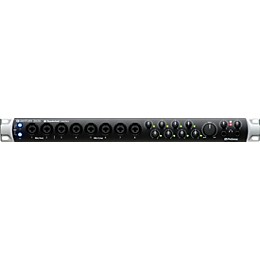
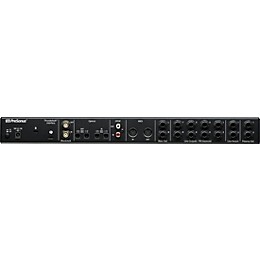
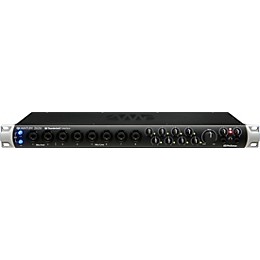
 Features
Features
- Simultaneous I/O up to 26 inputs/26 outputs (at 44.1 or 48kHz)
- 8 pristine XMAX preamps
- 2 Instrument Inputs
- 8 balanced line inputs
- Dual headphone outputs with independent level control
- Balanced stereo main outputs with independent level control
- 8 DC Coupled balanced line outputs
- 2 preamp direct outputs with returns to insert outboard gear
- Main Output Level Control
- Balanced Stereo Main Output (TRS)
- Eight Balanced Line Outputs (TRS: Outs 1 & 2 share a DAC with the main output)
- Two Preamp Outputs (channels 1 & 2)
- Two Line Returns (channels 1 & 2)
- ADAT Optical/Dual SMUX inputs/outputs: 16x16 channels at 44.1kHz or 48kHz; 8x8 channels at 88.2 or 96kHz
- Stereo S/PDIF coaxial input and output
- Thunderbolt 3 high-speed bus
- 24-bit resolution and up to 192 kHz sampling rate
- BNC word clock input and output with low-jitter clocking
- MIDI I/O
- Road-rugged construction with all-metal chassis and metal knobs
- 1U rackmountable
- 12 VDC external power supply (included)
 Specs
Specs
- Max bit depth: 24-bit
- Max sampling rate: 192kHz
- Frequency response: 20Hz–20kHz
- Connection Type: Thunderbolt 3 (Thunderbolt 1 and 2 compatible)
- ADC Dynamic Range: 115dB (A-wtd)
- DAC Dynamic Range: 115dB (A-wtd)
- Bit Depth: 24 bits
- Internally Supported Sample Rates: 44.1, 48, 88.2, 96, 176.4, 192kHz
- Type: XLR Female (via Combo), Balanced
- Maximum Input Level: +10dBu (Balanced, min. gain)
- Gain Control Range: 60dB
- Dynamic Range: > 110dB (A-wtd, min. gain)
- EIN: < -131 dBu (max gain, 40 ohm, 22kHz BW, A-wtd)
- Input Impedance: 1.6 kohm
- Phantom Power: +48V, > 8 mA per input
- Type: ¼” TS Female (via Combo), Unbalanced
- Maximum Input Level: +15dBu (Unbalanced, min. gain)
- Gain Control Range: 60dB
- Dynamic Range: > 106dB (A-wtd, min. gain)
- Total Harmonic Distortion: < 0.005% (1kHz, min. gain)
- Input Impedance: > 1 mohm
- Type: 1/4” TRS Female (via Combo), Balanced
- Maximum Input Level: + 18 dBu (Balanced, min. gain)
- Dynamic Range: > 118dB (A-wtd, min. gain)
- Input Impedance: 10 kohm
- Type: 1/4” TRS Female, impedance balanced, DC Coupled (Line Outputs only)
- Maximum Output Level: +18 dBu (Balanced)
- Frequency Response: 20Hz to 20kHz (±0.05dB, unity gain, 48kHz)
- Dynamic Range: > 118dB (A-wtd)
- Output Impedance: 51 ohm
- Type: 1/4” TRS Female, Stereo, Unbalanced, x2
- Maximum Output Level: 175 mW/channel (56Ω load)
- Dynamic Range: > 110 dB (A-wtd)
- Headphone Impedance (working range): 16 ohm to 300 ohm
- Jitter: < 70 ps RMS (20Hz–20kHz)
- Jitter Attenuation: > 60dB (1 ns in => 1 ps out)
- 12 VDC, 5A, external power supply
- Height: 1.75" (44.45 mm)
- Depth: 7" (177.8 mm)
- Width: 19" (482.6 mm)
- Weight: 6 lb. (2.72 kg)
- Mac OS X 10.11.6 64-bit or later
- Intel Core i5 or better
- 4GB RAM (8 GB or more recommended)
- Windows 10 64-bit or later
- Intel Core i5 or better
- 4GB RAM (8 GB or more recommended)
- Thunderbolt 1.0, 2.0, or 3.0 port (NOTE: Your computer's motherboard must support Thunderbolt. Thunderbolt 1 and 2 require an adapter, not included.)
- Internet connection (required for Studio One Activation and Content download)
- Internal or external 7200 RPM storage drive highly recommended
- 30GB hard disk space
- Monitor with 1366x768 resolution
 Warranty
Warranty
Featured Articles
 Reviews
Reviews
3.17
6 Reviews
50%
of respondents would recommend this to a friend
- Home Studio5
- Amateur Recording2
- Professional Recording2
- Outdoor Events / Games1
- Performances1
- Unreliable2
- Hard to get it the driver to work correctly.1
- You have to buy your own thunderbolt 3 cable.1
- Customer Support1
- Professional Musician4
- Experienced2
- Good Audio5
- Versatile3
- Durable2
- Easy To Use2
- Compact1
Reviewed by 6 customers
Had to return due to MIDI Latency issues unresolved.
submitted3 years ago
byBen
fromLongmont CO
I needed 8 inputs to record drums, so the 2626 was the least expensive way to achieve this. I hadn't researched enough to hear the issues others were having, across all platforms and software, including dropped notes, notes randomly "bouncing" when playing a chord. Also, I had random note drop-out with any notes faster than 8th notes. My heart sank as a week of research, tutorials and tweaking latency times in Logic Pro failed to solve it. Butch is the sole tech guy at Presonus, and he started off great but as soon as I bought up latency...crickets and have never heard back. So I took it back today and am buying a MOTU.
Great product, driver issues have been fixed
submitted4 years ago
byNick
fromBoston, Ma
Great product. There were driver issues in the past that have been remedied. For example, switching audio output sources (ex. spotify, youtube etc.) would crash the sound card unless Studio one is running. This problem has been fixed. Low latency, preamps sound great. All the knobs, inputs, outputs etc. work as expected. High quality build.
It was a headache getting the driver to work, finaly.
submitted4 years ago
byKamal, N
fromSpring Hill, Florida
Live recording and software based recording.
The most affordable high quality low latency sound interface
submitted4 years ago
byMike P.
fromLouisville, KY
When I first started recording music, (early 2000's) to record a band, high quality; with zero latency would cost a studio and/or engineer $100,000's worth of studio equipment and software. Basically, what I'm trying to say is (thanks to Presonus) now the middle class can have the tools to do what was once only reserved for the elite few.
After a few years of use, still extremely buggy drivers.
submitted4 years ago
byDavid, W
fromHouston, TX
I've had a 2626 for a few years now and I've used it on multiple different computers. When it works, it's awesome. Very low latency. The problem is that it continues to have extremely buggy drivers that will cause the audio to just stop. You will need to restart the unit or, in some cases, restart the computer to get audio back. I would estimate this problem will happen about once for every 90 minutes of use. It is a well known problem and is complained about quite a bit on the Presonus forums, but after years of complaints form countless users, Presonus are still pretending it's not happening. I only use Win 10 64 bit systems, but I've seen Mac users in the forums with this problem as well. The bottom line is Presonus are not going to fix the issue. Unless you are OK with restarting every 90 minutes or so, I wouldn't bother with a 2626. It is an exercise in frustration.
Really poor customer service but seemingly decent product
submitted4 years ago
byJason, M
fromSan Jose, CA
Positives: The 2626 seemingly has a lot of features, and was the only TB3 interface I could find at < $1k with enough inputs to track drums. Negatives: The 2626 comes with its own internal software mixer (not the problem). I've not been able to get this to launch after several re-installs, etc. I wrote to Presonus' Support and just get one sentence answers that they don't support the software, only the hardware. So I have to do unnatural workarounds to plug in physical compressors and pre-amps etc because I can't adjust the Presonus' internal routing that's controlled by their "Universal Control" mixer app that they don't support. Surprisingly terrible customer service for what I thought was a more premium brand.
- Previous
- 1
- Next
 Q&A
Q&A
Have a question about this product? Our expert Gear Advisers have the answers.
submitted4 years ago
asked byjames
fromSanta Monica, ca
CAN THE QUANTUM 2626 BE USED WITHOUT THE STUDIO ONE SOFTWARE ?
No, it cannot


